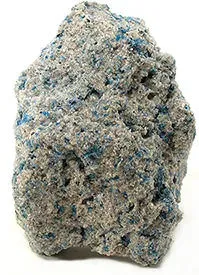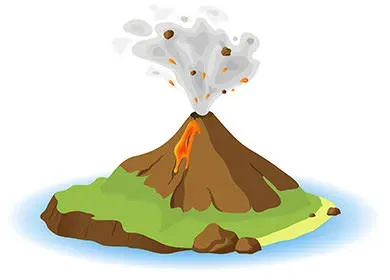 Hauyne is also called hauynite. It is a rare silicate known for its beautiful, intense, and bright blue color. Hauyne was first discovered in 1807 in the south of Italy, among Vesuvian lavas on Monte Somma. Hauyne was named by R.J. Hauy, a famous French mineralogist and a pioneer in crystallography. Hauyne is a stone with perfect cleavage, so it is very rare for the stone to be cut and faceted because cutting a stone with perfect cleavage is very difficult. Hauyne is therefore only usually faceted for collectors and is thus, very expensive. Stones with a deep
Hauyne is also called hauynite. It is a rare silicate known for its beautiful, intense, and bright blue color. Hauyne was first discovered in 1807 in the south of Italy, among Vesuvian lavas on Monte Somma. Hauyne was named by R.J. Hauy, a famous French mineralogist and a pioneer in crystallography. Hauyne is a stone with perfect cleavage, so it is very rare for the stone to be cut and faceted because cutting a stone with perfect cleavage is very difficult. Hauyne is therefore only usually faceted for collectors and is thus, very expensive. Stones with a deep ![]() sapphire blue color are the most desirable and expensive. Faceted stones are also typically small.
sapphire blue color are the most desirable and expensive. Faceted stones are also typically small.
 Hauyne forms as small parts inside
Hauyne forms as small parts inside ![]() lapis lazuli. It is usually found not as individual crystals, but rather intergrown with other minerals. Hauyne is similar in composition to lazurite, as well as other members of its sodalite group, such as sodalite, nosean, bicchulite, kamaishilite, tugtupite, and tsaregorodtsevite. Hauyne can be blue, gray, brown or yellow-green. It rates a 5.5 to 6 on the hardness scale. It is a brittle stone, with a vitreous to greasy luster, and is transparent to translucent. Twinning is common in these well-formed coarse crystals. Hauyne occurs typically as small rounded grains in silica-poor, alkali-rich volcanic rocks, such as phonolites, which are composed of alkali feldspars and nepheline.
lapis lazuli. It is usually found not as individual crystals, but rather intergrown with other minerals. Hauyne is similar in composition to lazurite, as well as other members of its sodalite group, such as sodalite, nosean, bicchulite, kamaishilite, tugtupite, and tsaregorodtsevite. Hauyne can be blue, gray, brown or yellow-green. It rates a 5.5 to 6 on the hardness scale. It is a brittle stone, with a vitreous to greasy luster, and is transparent to translucent. Twinning is common in these well-formed coarse crystals. Hauyne occurs typically as small rounded grains in silica-poor, alkali-rich volcanic rocks, such as phonolites, which are composed of alkali feldspars and nepheline.
 The most well known sites for hauyne are the ancient volcanoes in Germany and Morocco. Major deposits are also found in the Lazio and Tuscany regions of West-Central Italy. Other sources around the world include Cygnet, Tasmania; Catalonia, northeast Spain; the Eiffel Mountains, Rhineland-Palatinate, western Germany and Kaiserstuhl, Baden Wurttemberg, southwest Germany; and the remote Sumaco Volcano, in north central Ecuador. Hauyne has also been found in various locations around Austria, and Sweden. Deposits within the United States include those in Sussex County New Jersey, Colfax County, New Mexico, and St Lawrence Count, New York.
The most well known sites for hauyne are the ancient volcanoes in Germany and Morocco. Major deposits are also found in the Lazio and Tuscany regions of West-Central Italy. Other sources around the world include Cygnet, Tasmania; Catalonia, northeast Spain; the Eiffel Mountains, Rhineland-Palatinate, western Germany and Kaiserstuhl, Baden Wurttemberg, southwest Germany; and the remote Sumaco Volcano, in north central Ecuador. Hauyne has also been found in various locations around Austria, and Sweden. Deposits within the United States include those in Sussex County New Jersey, Colfax County, New Mexico, and St Lawrence Count, New York.
 Hauyne is a stone that represents joy, laughter, and resurrection. It teaches us that we can give with a free heart; that giving and taking is a cycle, one is dependant on the other. It stresses that redemption and resurrection actually free our hearts. Giving is always misunderstood as we usually view it as a sacrifice when really, it is a joy. Hauyne emphasizes that when we can give to the point where we feel uncomfortable, we will experience redemption and inner resurrection. Hauyne has the power to release what is in our hearts, whether it be positive feelings of joy, happiness, beauty, affection, caring, and love, or negative feelings such as sadness, sympathy, pain, or hopelessness. Hauyne helps us to understand that we will experience a joyous resurrection once we release these inner feelings.
Hauyne is a stone that represents joy, laughter, and resurrection. It teaches us that we can give with a free heart; that giving and taking is a cycle, one is dependant on the other. It stresses that redemption and resurrection actually free our hearts. Giving is always misunderstood as we usually view it as a sacrifice when really, it is a joy. Hauyne emphasizes that when we can give to the point where we feel uncomfortable, we will experience redemption and inner resurrection. Hauyne has the power to release what is in our hearts, whether it be positive feelings of joy, happiness, beauty, affection, caring, and love, or negative feelings such as sadness, sympathy, pain, or hopelessness. Hauyne helps us to understand that we will experience a joyous resurrection once we release these inner feelings.